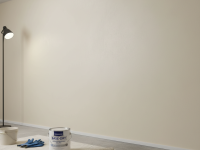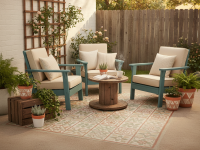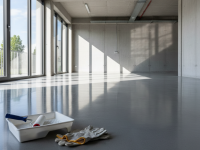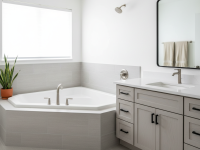Silence Your Space: Budget-Friendly Soundproofing Hacks for Your Home Office (Seriously!)
Ah, the home office. A place where dreams are made, deadlines are met, and… sometimes, it feels like a battleground against every stray noise imaginable. I get it. I’ve been there. One minute you’re deep in thought, crafting that perfect email, and the next, your neighbour’s lawnmower kicks in, the kids decide it’s a wrestling match day, or the delivery truck pulls up with its rumbling engine. Suddenly, your “professional” Zoom call sounds more like a chaotic zoo, and your focus? Gone with the wind.
You might think soundproofing your home office requires a huge investment, tearing down walls, and hiring expensive contractors. But what if I told you it doesn’t have to be that way? As someone who’s battled and ultimately conquered the noise monster in my own home office without breaking the bank, I’m here to share some practical, wallet-friendly tips that actually work. We’re talking about creating a peaceful, productive sanctuary where you can truly focus, without having to take out a second mortgage.
Understanding Sound: What Are We Fighting?
Before we dive into the solutions, let’s briefly understand the enemy. Sound isn’t magic; it’s vibrations traveling through the air and solid objects. When we talk about soundproofing, we’re essentially trying to do three main things:
- Block it: Preventing sound from entering or leaving your space. This usually involves adding mass and sealing gaps.
- Absorb it: Soaking up sound waves within your room to reduce echo and reverb.
- Diffuse it: Scattering sound waves to prevent harsh reflections.
On a budget, we’ll primarily focus on blocking and absorbing, as they offer the most bang for your buck.
The Low-Hanging Fruit: Plugging Gaps and Sealing Leaks
Think of your office like a leaky bucket. If you want to keep water in (or out), you need to plug the holes first. Sound works similarly. Even tiny gaps can let a surprising amount of noise in.
Doors: Your First Line of Defense
Doors are often the biggest culprit for noise leakage. If you have a hollow-core door, that’s already a challenge, but we can still improve it!
- Door Sweeps/Draft Stoppers: This was one of my first and most impactful investments. A simple door sweep (the brush-like strip at the bottom) can drastically reduce noise creeping under the door. You can find these for as little as $10-$20. Pair it with an interior draft stopper (a fabric snake filled with sand or beans) for extra oomph, especially if you have a larger gap.
- Weatherstripping: Those thin adhesive strips that go around the door frame aren’t just for keeping out drafts; they’re excellent at sealing the tiny gaps between the door and the frame. It’s cheap, easy to install, and makes a noticeable difference.
- Heavy Curtains or Blankets: For a quick, temporary, and effective fix, hang a heavy moving blanket or a thick, insulated curtain over your door. Use a tension rod or sturdy hooks. It adds mass and helps absorb sound, particularly useful if you’re on a call. I’ve even used a thick quilt in a pinch, and it worked wonders!
Windows: The Glassy Gateway to Noise
Windows are another common entry point for external noise. Street traffic, barking dogs, construction – it all seems to find its way through glass.
- Heavy, Thermal Curtains/Drapes: This is a classic for a reason. Thick, layered curtains or drapes (especially those marketed as “thermal” or “blackout”) add mass and multiple layers, which significantly dampen sound. Make sure they extend past the window frame and go all the way to the floor for maximum effect. Layering two sets of curtains (e.g., a sheer one under a heavy one) can work even better.
- Weatherstripping for Windows: Just like with doors, applying weatherstripping around your window frames can seal those small gaps that let noise seep in.
- DIY Secondary Glazing (Budget Version): If you’re feeling a bit handy, consider cutting a sheet of clear acrylic or plexiglass to fit inside your window frame. You can secure it with clips or even magnetic strips. This creates an extra air gap, which is fantastic for insulation against sound and temperature. It’s cheaper than professional secondary glazing but surprisingly effective.
Absorbing the Echo: Taming Reverb with Soft Surfaces
Once you’ve blocked as much external noise as possible, the next step is to tackle the sound *within* your room. A room with hard surfaces (bare walls, hardwood floors) will bounce sound around, creating echo and making your space sound “live” or harsh. This is where absorption comes in.
Floors: Laying Down Some Quiet
- Thick Area Rugs or Carpets: If you have hard floors, a large, thick area rug (or multiple rugs) is a game-changer. The thicker the rug and the denser the pile, the better it will absorb sound. Adding a rug pad underneath enhances its absorption capabilities and adds a layer of comfort. This was one of my go-to solutions, and the difference was immediate.
Walls: From Bare to Beautifully Buffered
- Bookcases Filled with Books: This is a win-win. Bookshelves full of books (or even other objects) act as excellent sound diffusers and absorbers. The irregular surfaces break up sound waves, and the sheer mass helps block noise. Position them against walls that face noisy areas.
- Thick Wall Hangings, Tapestries, or Quilts: Forget expensive acoustic panels for a moment. A large, thick tapestry, a heavy quilt, or even a couple of moving blankets hung on the walls can do a fantastic job of soaking up sound. Look for vintage quilts or tapestries at thrift stores or online marketplaces for budget-friendly options. The more surface area they cover, the better.
- DIY Fabric Panels: If you’re feeling crafty, you can create simple fabric-wrapped panels. Use cheap insulation material (like mineral wool or rigid foam board – check local hardware stores), wrap it tightly in an appealing fabric, and hang it on the wall. This is a more effective absorption method than just fabric alone.
Ceilings: Don’t Forget Up High!
Sound can bounce off your ceiling too! While ceiling-specific acoustic tiles can be pricey, you can still make a difference:
- Thick Rug or Quilt on the Ceiling: For a truly budget-conscious (and perhaps aesthetically daring) approach, you can hang a thick rug or quilt securely from the ceiling. It’s not for everyone, but it’s effective for absorption.
- Textured Wallpaper or Fabric: Adding textured wallpaper or adhering fabric to a section of your ceiling can help disrupt sound waves and provide some absorption.
Strategic Placement: Where to Put Your Stuff
Sometimes, simply rearranging your office can make a difference.
- Position Your Desk Wisely: If possible, avoid placing your desk directly against a wall that’s shared with a noisy room or faces a busy street. If you must, try to create a buffer.
- Use Furniture as Barriers: Place tall, solid pieces of furniture like bookcases or filing cabinets against walls that are particularly prone to transmitting noise. They add mass and help block sound.
Don’t Forget the Tech: Small Helpers for Big Impact
While these don’t technically “soundproof” your room, they can significantly enhance your personal quiet.
- Noise-Cancelling Headphones: This is personal soundproofing at its best. A good pair of noise-cancelling headphones can be a lifesaver for focus, especially during calls or when you need intense concentration. It blocks out surrounding distractions, allowing you to create your own quiet bubble.
- White Noise Machine or Apps: White noise doesn’t block sound, but it masks it. By creating a consistent, soothing background hum, it makes intermittent disruptive noises less noticeable. This can be incredibly effective for improving focus without actually “soundproofing” the room itself. Many free apps offer various white noise options.
My Personal Journey to Quiet
When I first started working from home, my office was anything but quiet. I had a busy street outside, a partner on constant video calls in the next room, and a dog who thought every passing squirrel was an invasion. I started with the door sweep and some heavy curtains, which immediately made a noticeable difference to the traffic noise. Then, I repurposed an old, thick rug from storage and placed it under my desk, which instantly reduced the echo in my small room.
My biggest “aha!” moment came when I hung a large, vintage quilt I found at a flea market on the wall behind my desk. Not only did it add a touch of personality, but it also dramatically improved the sound quality for my video calls, absorbing the harsh reflections that used to make my voice sound tiy. It wasn’t perfect silence, but the improvement in my ability to focus and the professional sound of my calls was priceless, and it cost me less than $100 in total for all the major changes.
Conclusion: Your Peaceful Workspace Awaits
Soundproofing your home office on a budget is absolutely achievable. You don’t need to be an acoustics expert or have a bottomless wallet. By focusing on sealing gaps, adding mass, and incorporating soft, absorbent materials, you can transform your noisy workspace into a tranquil haven of productivity.
Start with the easiest, cheapest options first, like sealing your door and windows. Then, gradually add soft furnishings, rugs, and wall hangings. Even small changes can make a significant impact on your focus, stress levels, and overall work-from-home experience. So go ahead, reclaim your peace and quiet. Your future productive self will thank you for it!
1. A person working calmly and focused in a cozy home office. The office looks well-organized with natural light, showing an atmosphere of peace and concentration.
2. A close-up shot of a closed wooden door with a dark-colored door sweep installed at the bottom, and thin, white weatherstripping visible along the door frame.
3. A home office interior featuring a large window covered by thick, floor-length, layered curtains. A plush area rug covers a significant portion of the hardwood floor, and a tall, filled bookcase stands against an adjacent wall.
4. A person smiling and looking relaxed while wearing modern, over-ear noise-cancelling headphones at their home office desk, with a laptop visible in the background.



